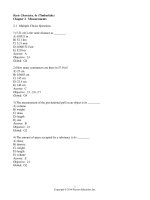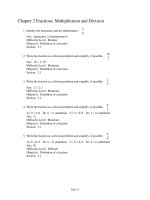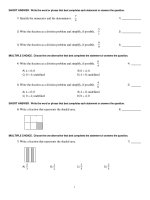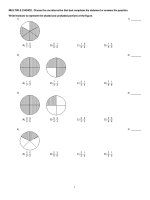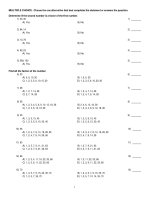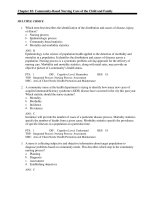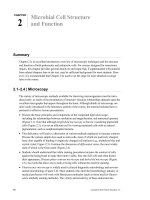Foundations of college chemistry 14th edition hein test bank
Bạn đang xem bản rút gọn của tài liệu. Xem và tải ngay bản đầy đủ của tài liệu tại đây (110.67 KB, 36 trang )
Package Title: Hein Test Bank
Course Title: Hein 14e
Chapter Number: 2
Question type: Multiple Choice
1) Which of the following is the SI prefix that means 1000?
a) milli
b) centi
c) deci
d) kilo
Answer: D
Difficulty: easy
Learning Objective 1: Name the units for mass, length, and volume in the metric system and
convert from one unit to another.
Section Reference 1: Section 2.5
2) The number, 14.74999, when rounded to three digits is ___.
a) 15.0
b) 14.8
c) 14.7
d) 10.0
Answer: C
Difficulty: easy
Learning Objective 1: Determine the number of significant figures in a given measurement and
round measurements to a specific number of significant figures.
Section Reference 1: Section 2.3
3) How many significant figures are in the number 0.0032?
a) 1
b) 2
c) 3
d) 4
1
Answer: B
Difficulty: easy
Learning Objective 1: Determine the number of significant figures in a given measurement and
round measurements to a specific number of significant figures.
Section Reference 1: Section 2.3
4) How many significant figures are in the number 1.500?
a) 1
b) 2
c) 3
d) 4
Answer: D
Difficulty: easy
Learning Objective 1: Determine the number of significant figures in a given measurement and
round measurements to a specific number of significant figures.
Section Reference 1: Section 2.3
5) How many significant figures are in the number 14.04?
a) 1
b) 2
c) 3
d) 4
Answer: D
Difficulty: easy
Learning Objective 1: Determine the number of significant figures in a given measurement and
round measurements to a specific number of significant figures.
Section Reference 1: Section 2.3
6) How many significant figures are in the number 0.0015070?
a) 5
b) 4
c) 7
d) 8
2
Answer: A
Difficulty: easy
Learning Objective 1: Determine the number of significant figures in a given measurement and
round measurements to a specific number of significant figures.
Section Reference 1: Section 2.3
7) How many significant figures are in the number 0.0050?
a) 1
b) 2
c) 3
d) 4
Answer: B
Difficulty: easy
Learning Objective 1: Determine the number of significant figures in a given measurement and
round measurements to a specific number of significant figures.
Section Reference 1: Section 2.3
8) How many significant digits are in the number 1.30 × 104?
a) 1
b) 2
c) 3
d) 4
Answer: C
Difficulty: easy
Learning Objective 1: Determine the number of significant figures in a given measurement and
round measurements to a specific number of significant figures.
Section Reference 1: Section 2.3
9) The density of a solid is 1.36 g/mL. The specific gravity of the substance is ___.
a) 1.00
b) 1.40
c) 1.36
d) cannot be determined
3
Answer: C
Difficulty: easy
Learning Objective 1: Solve problems involving density.
Section Reference 1: Section 2.8
10) One kilometer is equal to ___.
a) 0.001 m
b) 0.01 m
c) 100 m
d) 1000 m
Answer: D
Difficulty: easy
Learning Objective 1: Name the units for mass, length, and volume in the metric system and
convert from one unit to another.
Section Reference 1: Section 2.5
11) One centigram is equal to ___.
a) 0.001 g
b) 0.01 g
c) 100 g
d) 1000 g
Answer: B
Difficulty: easy
Learning Objective 1: Name the units for mass, length, and volume in the metric system and
convert from one unit to another.
Section Reference 1: Section 2.5
12) The prefixes nano and mega correspond to which of the following pair, respectively?
a) 109 and 106
b) 106 and 10-9
c) 10–9 and 106
d) 10–9 and 109
Answer: C
4
Difficulty: medium
Learning Objective 1: Name the units for mass, length, and volume in the metric system and
convert from one unit to another.
Section Reference 1: Section 2.5
13) The temperature of 295 K is equal to which Fahrenheit temperature?
a) 72 °F
b) 41 °F
c) 44 °F
d) 32 °F
Answer: A
Difficulty: medium
Learning Objective 1: Convert measurements among the Fahrenheit, Celsius, and Kelvin
temperature scales.
Section Reference 1: Section 2.7
14) The temperature of –100. °C is equal to ___.
a) –173 K
b) –137 K
c) 137 K
d) 173 K
Answer: D
Difficulty: easy
Learning Objective 1: Convert measurements among the Fahrenheit, Celsius, and Kelvin
temperature scales.
Section Reference 1: Section 2.7
15) A temperature of 100. K is equal to which Celsius temperature?
a) –173 °C
b) –137 °C
c) 237 °C
d) 273 °C
Answer: A
5
Difficulty: easy
Learning Objective 1: Convert measurements among the Fahrenheit, Celsius, and Kelvin
temperature scales.
Section Reference 1: Section 2.7
16) The temperature of 40.0 °Fahrenheit is equal to which Celsius temperature?
a) 4.44 °C
b) 20.0 °C
c) 45.0 °C
d) 115 °C
Answer: A
Difficulty: medium
Learning Objective 1: Convert measurements among the Fahrenheit, Celsius, and Kelvin
temperature scales.
Section Reference 1: Section 2.7
17) The temperature of 40.0 degrees Celsius is equal to which Fahrenheit temperature?
a) 23.0 °F
b) 13.0 °F
c) 74.0 °F
d) 104 °F
Answer: D
Difficulty: medium
Learning Objective 1: Convert measurements among the Fahrenheit, Celsius, and Kelvin
temperature scales.
Section Reference 1: Section 2.7
18) A piece of metal has a mass of 245 mg and volume of 15.3 mL. What is its density?
a) 16.0 g/cm3
b) 0.0160 g/cm3
c) 16013 g/cm3
d) 3.75x103 g/cm3
Answer: B
6
Difficulty: medium
Learning Objective 1: Solve problems involving density.
Section Reference 1: Section 2.8
19) A piece of metal has a mass of 86.24 g and a volume of 13.4mL. What is its density?
a) 0.155 g/mL
b) 6.44 g/mL
c) 72.8 g/mL
d) 99.6 g/mL
Answer: B
Difficulty: easy
Learning Objective 1: Solve problems involving density.
Section Reference 1: Section 2.8
20) What is the SI unit for temperature?
a) °C
b) K
c) °F
d) none of these choices
Answer: B
Difficulty: easy
Learning Objective 1: Solve problems involving density.
Section Reference 1: Section 2.8
21) A solid substance has a density of 4.36 g/mL. What is the volume of 30.0 g of this substance?
a) 0.145 mL
b) 6.88 mL
c) 34.36 mL
d) 131 mL
Answer: B
Difficulty: medium
Learning Objective 1: Solve problems involving density.
7
Section Reference 1: Section 2.8
22) A liquid has a density of 1.27 g/mL. What is the mass of 20.0 mL of this liquid?
a) 0.0635 g
b) 15.7 g
c) 21.3 g
d) 25.4 g
Answer: D
Difficulty: medium
Learning Objective 1: Solve problems involving density.
Section Reference 1: Section 2.8
23) Convert 1.00 in2 to cm2.
a) 2.54 cm2
b) 6.45 cm2
c) 1.00 cm2
d) 0.16 cm2
Answer: B
Difficulty: medium
Learning Objective 1: Use dimensional analysis to solve problems involving unit conversions.
Section Reference 1: Section 2.6
24) The number 0.02857 rounded to three significant figures is ___.
a) 0.029
b) 0.0285
c) 0.0286
d) 0.03
Answer: C
Difficulty: easy
Learning Objective 1: Apply the rules for significant figures in calculations involving addition,
subtraction, multiplication and division.
Section Reference 1: Section 2.4
8
25) Convert 3.00 in. to centimeters.
a) 1.18 cm
b) 2.54 cm
c) 7.62 cm
d) 10.2 cm
Answer: C
Difficulty: easy
Learning Objective 1: Use dimensional analysis to solve problems involving unit conversions.
Section Reference 1: Section 2.6
26) Convert 3.00 centimeters into inches.
a) 1.18 in.
b) 2.54 in.
c) 7.62 in.
d) 10.2 in.
Answer: A
Difficulty: easy
Learning Objective 1: Use dimensional analysis to solve problems involving unit conversions.
Section Reference 1: Section 2.6
27) Which SI unit is most appropriate to measure the distance between Chicago and Detroit?
a) millimeter
b) centimeter
c) meter
d) kilometer
Answer: D
Difficulty: medium
Learning Objective 1: Name the units for mass, length and volume in the metric system and
convert from one unit to another.
Section Reference 1: Section 2.5
28) Which SI unit is most appropriate to measure the thickness of a dime?
9
a) meter
b) millimeter
c) decimeter
d) kilometer
Answer: B
Difficulty: medium
Learning Objective 1: Name the units for mass, length and volume in the metric system and
convert from one unit to another.
Section Reference 1: Section 2.5
29) Multiply (40.36) by (37.40). The product expressed to the proper number of significant
figures is ___.
a) 151
b) 1509
c) 1510.
d) 1509.464
Answer: B
Difficulty: easy
Learning Objective 1: Apply the rules for significant figures in calculations involving addition,
subtraction, multiplication and division.
Section Reference 1: Section 2.4
30) Divide 1436 by 203. The quotient expressed to the proper number of significant figures is
___.
a) 0.141
b) 0.1414
c) 7.07
d) 7.074
Answer: C
Difficulty: easy
Learning Objective 1: Apply the rules for significant figures in calculations involving addition,
subtraction, multiplication and division.
Section Reference 1: Section 2.4
10
31) Add 114.32 + 12.1 + 13. The sum expressed to the proper number of significant figures is
___.
a) 139
b) 139.4
c) 139.42
d) 140
Answer: A
Difficulty: easy
Learning Objective 1: Apply the rules for significant figures in calculations involving addition,
subtraction, multiplication and division.
Section Reference 1: Section 2.4
32) Subtract 14.3 from 130.670. The difference expressed to the correct number of significant
figures is ___.
a) 116
b) 116.3
c) 116.4
d) 116.37
Answer: C
Difficulty: easy
Learning Objective 1: Apply the rules for significant figures in calculations involving addition,
subtraction, multiplication and division.
Section Reference 1: Section 2.4
33) How many significant figures should be included in the answer to the following calculation?
(3.48) (3.6) / 2.470
a) 1
b) 2
c) 3
d) 4
Answer: B
Difficulty: easy
Learning Objective 1: Apply the rules for significant figures in calculations involving addition,
subtraction, multiplication and division.
11
Section Reference 1: Section 2.4
34) How many significant figures should be included in the answer to the following calculation?
(3.60) (2.489) (5.1110)
a) 2
b) 3
c) 4
d) 5
Answer: B
Difficulty: easy
Learning Objective 1: Apply the rules for significant figures in calculations involving addition,
subtraction, multiplication and division.
Section Reference 1: Section 2.4
35) How many significant figures should be included in the answer to the following calculation?
(3.4876) / (4.11+ 1.2)
a) 2
b) 3
c) 4
d) 5
Answer: A
Difficulty: Medium
Learning Objective 1: Apply the rules for significant figures in calculations involving addition,
subtraction, multiplication and division.
Section Reference 1: Section 2.4
36) How many zeroes are significant in the number 0.0040?
a) 1
b) 2
c) 3
d) 4
Answer: A
Difficulty: medium
12
Learning Objective 1: Determine the number of significant figures in a given measurement and
round measurements to a specific number of significant figures.
Section Reference 1: Section 2.3
37) How many zeroes are significant in the number 0.030030?
a) 1
b) 2
c) 3
d) 4
Answer: C
Difficulty: medium
Learning Objective 1: Determine the number of significant figures in a given measurement and
round measurements to a specific number of significant figures.
Section Reference 1: Section 2.3
38) How many zeroes are significant in the number 40400302?
a) 1
b) 2
c) 3
d) 4
Answer: D
Difficulty: medium
Learning Objective 1: Determine the number of significant figures in a given measurement and
round measurements to a specific number of significant figures.
Section Reference 1: Section 2.3
39) How many zeroes are significant in the number 30000?
a) 1
b) 2
c) 3
d) 4
Answer: D
Difficulty: medium
13
Learning Objective 1: Determine the number of significant figures in a given measurement and
round measurements to a specific number of significant figures
Section Reference 1: Section 2.3
40) What numerical value is indicated by the SI prefix milli?
a) 1/100
b) 1/1000
c) 100
d) 1000
Answer: B
Difficulty: easy
Learning Objective 1: Name the units for mass, length and volume in the metric system and
convert from one unit to another.
Section Reference 1: Section 2.5
41) Convert 4.30 feet into centimeters.
a) 10.9 cm
b) 30.5 cm
c) 131 cm
d) 151 cm
Answer: C
Difficulty: medium
Learning Objective 1: Use dimensional analysis to solve problems involving unit conversions
Section Reference 1: Section 2.6
42) Convert 10.00 g into decigrams.
a) 1.000 dg
b) 10.00 dg
c) 100.0 dg
d) 1000. dg
Answer: C
Difficulty: medium
Learning Objective 1: Name the units for mass, length and volume in the metric system and
14
convert from one unit to another.
Section Reference 1: Section 2.5
43) The density of copper is 8.96 g/mL. The mass of 7.00 mL of copper is ___.
a) 62.7 g
b) 1.28 g
c) 0.781 g
d) 1.96 g
Answer: A
Difficulty: medium
Learning Objective 1: Solve problems involving density.
Section Reference: Section 2.8
44) The density of copper is 8.96 g/mL. The volume of 12 mg of copper is ___.
a) 1.3 mL
b) 0.0013 mL
c) 13 mL
d) 13 mL
Answer: b
Difficulty: difficult
Learning Objective 1: Solve problems involving density.
Section Reference 1: Section 2.8
45) The mass of a substance is 17.46 g and its volume is 3.42 mL. What is the density of the
substance rounded to the correct number of significant figures?
a) 0.1959 g/mL
b) 0.196 g/mL
c) 5.105 g/mL
d) 5.11 g/mL
Answer: D
Difficulty: medium
Learning Objective 1: Determine the number of significant figures in a given measurement and
round measurements to a specific number of significant figures.
15
Learning Objective 2: Solve problems involving density.
Section Reference 1: Sections 2.3 and 2.8
46) Convert 30.0 ml to liters.
a) 0.0300 L
b) 0.00300 L
c) 300. L
d) 30000 L
Answer: A
Difficulty: easy
Learning Objective 1: Name the units for mass, length and volume in the metric system and
convert from one unit to another.
Section Reference 1: Section 2.5
47) The space occupied by a sample is its ___.
a) mass
b) volume
c) length
d) temperature
Answer: B
Difficulty: easy
Learning Objective 1: Solve problems involving density.
Section Reference 1: Section 2.8
48) If the Celsius temperature of a sample changes twenty degrees, how many degrees does its
Kelvin temperature change?
a) 20
b) 257
c) 273
d) 293
Answer: A
Difficulty: easy
Learning Objective 1: Convert measurements among the Fahrenheit, Celsius and Kelvin
16
temperature scales.
Section Reference 1: Section 2.7
49) A rectangular piece of metal measures 8.0 cm by 1.20 m by 15.0 mm. What is its volume
rounded to the correct number of significant figures?
a) 14 cm3
b) 144 cm3
c) 1400 cm3
d) 1440 cm3
Answer: C
Difficulty: easy
Learning Objective 1: Apply the rules for significant figures in calculations involving addition,
subtraction, multiplication and division.
Learning Objective 2: Use dimensional analysis to solve problems involving unit conversions.
Section Reference 1: Sections 2.4 and 2.6
50) A cube measures 13.00 cm on edge. What is its volume?
a) 13.00 cm3
b) 169.0 cm3
c) 2197 cm3
d) 28600 cm3
Answer: C
Difficulty: easy
Learning Objective 1: Apply the rules for significant figures in calculations involving addition,
subtraction, multiplication and division.
Learning Objective 2: Use dimensional analysis to solve problems involving unit conversions.
Section Reference 1: Sections 2.4 and 2.6
51) A metal cube measures 8.60 cm on edge and has a density of 11.4 g/mL. What is its mass?
a) 98.0g
b) 843g
c) 7250g
d) 62400g
Answer: C
17
Difficulty: hard
Learning Objective 1: Solve problems involving density.
Section Reference 1: Section 2.8
52) A 48.0-g piece of metal is dropped into 50.0 mL of water in a graduated cylinder. The water
level rises to 62.4 mL. What is the density of the metal?
a) 12.4 g/mL
b) 0.258 g/ml
c) 3.87 g/mL
d) 595 g/ml
Answer: C
Difficulty: medium
Learning Objective 1: Solve problems involving density.
Section Reference: Section 2.8
53) One centimeter is equal to ___.
a) 2.54 in.
b) 0.394 in.
c) 12.0 in.
d) 0.100 in.
Answer: B
Difficulty: easy
Learning Objective 1: Use dimensional analysis to solve problems involving unit conversions.
Section Reference 1: Section 2.6
54) An empty graduated cylinder has a mass of 68.00 g. 50.0 mL of water is added to the cylinder
and its mass increases to 109.5 g. What is the density of the liquid?
a) 41.5 g/ml
b) 1.20 g/mL
c) 0.830 g/mL
d) 1.36 g/mL
Answer: C
18
Difficulty: medium
Learning Objective 1: Solve problems involving density.
Section Reference 1: Section 2.8
55) A car gets 25.6 miles per gallon of gasoline. A full tank of gasoline contains 56.8 L. How
many miles can this car travel on a full tank of gasoline? ( 1.000 L = 1.057 qt )
a) 1454 mi
b) 96.9 mi
c) 1.71 mi
d) 384 mi
Answer: D
Difficulty: medium
Learning Objective 1: Use dimensional analysis to solve problems involving unit conversions.
Section Reference 1: Section 2.6
56) Convert 4.34 yds to centimeters.
a) 4.34 cm
b) 132 cm
c) 264 cm
d) 397 cm
Answer: D
Difficulty: hard
Learning Objective 1: Use dimensional analysis to solve problems involving unit conversions.
Section Reference 1: Section 2.6
57) The number of centimeters in one inch is ___.
a) 0.109 cm
b) 0.328 cm
c) 0.394 cm
d) 2.54 cm
Answer: D
Difficulty: easy
Learning Objective 1: Use dimensional analysis to solve problems involving unit conversions.
19
Section Reference 1: Section 2.6
58) Add: 3.604 m + 104.29 m + 3.1 m + 17.41 m. The sum expressed in the correct number of
significant figures is ___.
a) 13 m
b) 128 m
c) 130 m
d) 128.4 m
Answer: D
Difficulty: easy
Learning Objective 1: Apply the rules for significant figures in calculations involving addition,
subtraction, multiplication and division.
Section Reference 1: Section 2.4
59) Subtract: 14.278 m from 106.31 m. The difference expressed in the correct number of
significant figures is ___.
a) 92.032 m
b) 92.03 m
c) 92.0 m
d) 92 m
Answer: B
Difficulty: easy
Learning Objective 1: Apply the rules for significant figures in calculations involving addition,
subtraction, multiplication and division.
Section Reference 1: Section 2.4
60) Multiply: (3.687) (14.1) (36.22). The product expressed in the correct number of significant
figures is ___.
a) 1882.9583
b) 188
c) 1883.0
d) 1880
Answer: D
20
Difficulty: easy
Learning Objective 1: Apply the rules for significant figures in calculations involving addition,
subtraction, multiplication and division.
Section Reference 1: Section 2.4
61) Divide: 34.72 by 4.7. The quotient expressed to the correct number of significant figures is
___.
a) 0.14
b) 0.1
c) 7.39
d) 7.4
Answer: D
Difficulty: easy
Learning Objective 1: Apply the rules for significant figures in calculations involving addition,
subtraction, multiplication and division.
Section Reference 1: Section 2.4
62) Divide: 32.14 by 0.204. The quotient expressed to the correct number of significant figures is
___.
a) 157.55
b) 158
c) 6347
d) 6350
Answer: B
Difficulty: easy
Learning Objective 1: Apply the rules for significant figures in calculations involving addition,
subtraction, multiplication and division.
Section Reference 1: Section 2.4
63) When expressed in proper scientific notation the number 4289 is ___.
a) 4.289 × 10-4
b) 4.289 × 10-3
c) 4.289 × 103
d) 4.289 ×104
21
Answer: C
Difficulty: easy
Learning Objective 1: Write decimal numbers in scientific notation.
Section Reference 1: Section 2.1
64) When expressed in proper scientific notation the number 286 is ___.
a) 2.86 × 101
b) 2.86 × 102
c) 2.86 × 10–2
d) 28.6 × 101
Answer: B
Difficulty: easy
Learning Objective 1: Write decimal numbers in scientific notation.
Section Reference 1: Section 2.1
65) When expressed in proper scientific notation the number 0.00364 is ___.
a) 3.64 × 103
b) 3.64 × 102
c) 3.64 × 10–2
d) 3.64 × 10–3
Answer: D
Difficulty: easy
Learning Objective 1: Write decimal numbers in scientific notation.
Section Reference 1: Section 2.1
66) When expressed in proper scientific notation the number 0.000034 is ___.
a) 3.4 × 104
b) 3.4 × 10–4
c) 3.4 × 103
d) 3.4 × 10–5
Answer: D
Difficulty: easy
Learning Objective 1: Write decimal numbers in scientific notation.
22
Section Reference 1: Section 2.1
67) Express the number 2.64 104 in decimal notation.
a) 0.000264
b) 0.0000264
c) 26400
d) 2640
Answer: C
Difficulty: easy
Learning Objective 1: Write decimal numbers in scientific notation.
Section Reference 1: Section 2.1
68) Express the number 3.00 10–3 in decimal notation.
a) 0.00300
b) 0.003
c) 3000.
d) 3000.
Commented [AW1]: Same answer
Answer: A
Difficulty: easy
Learning Objective 1: Write decimal numbers in scientific notation.
Section Reference 1: Section 2.1
69) Express the number 4.3170 10–4 in decimal notation.
a) 0.0043170
b) 0.00043170
c) 0.0004317
d) 43170
Answer: B
Difficulty: easy
Learning Objective 1: Write decimal numbers in scientific notation.
Section Reference 1: Section 2.1
23
70) Express the number 5.0 10–2 in decimal notation.
a) 500
b) 50
c) 0.050
d) 0.0050
Answer: C
Difficulty: easy
Learning Objective 1: Write decimal numbers in scientific notation.
Section Reference 1: Section 2.1
71) Multiply: ( 4.36 10–2 ) ( 3.17 104 ). When expressed properly the product is ___.
a) 1.38 × 103
b) 1.38 × 102
c) 1.38 × 10–2
d) 1.38 × 105
Answer: A
Difficulty: easy
Learning Objective 1:
Section Reference 1: Section 2.4
72) Multiply: ( 5.24 104 ) ( 2.36 10–5 ). When expressed properly the product is ___.
a) 1.24 × 10–1
b) 1.24 × 100
c) 1.24 × 101
d) 1.24 × 109
Answer: B
Difficulty: easy
Learning Objective 1: Apply the rules for significant figures in calculations involving addition,
subtraction, multiplication and division.
Section Reference 1: Section 2.4
73) Divide: 3.724 10–3 by 2.46 104. When expressed properly the result is ___.
24
a) 1.51 × 101
b) 1.51 × 10–7
c) 6.61 × 101
d) 6.61 × 102
Answer: B
Difficulty: easy
Learning Objective 1: Apply the rules for significant figures in calculations involving addition,
subtraction, multiplication and division.
Section Reference 1: Section 2.4
74) Divide: 4.863 104 by 2.12 104. When expressed properly the result is ___.
a) 4.36 × 10–1
b) 4.36 × 108
c) 2.29 × 108
d) 2.29 × 100
Answer: D
Difficulty: easy
Learning Objective 1: Apply the rules for significant figures in calculations involving addition,
subtraction, multiplication and division.
Section Reference 1: Section 2.4
75) Perform the following set of operations and choose the alternative that expresses the result to
the proper number of significant figures.
(1.5×10–4 * 61.3) + 2.01
a) 2.0192
b) 2.0
c) 2.019
d) 2.02
Answer: D
Difficulty: medium
Learning Objective 1: Apply the rules for significant figures in calculations involving addition,
subtraction, multiplication and division.
Section Reference 1: 2.4
25



